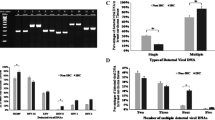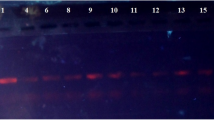Abstract
Purpose
Our previous study based on the results of polymerase chain reaction and Southern hybridization for the detection of Human papilloma virus (HPV), Cytomegalovirus (CMV), Epstein-Barr virus (EBV), Herpes simplex virus (HSV)-1, HSV-2, and Human herpesvirus (HHV)-8 DNA in non-familial breast cancer patients suggest that the viruses associated with breast cancer are HHV-8 > EBV (P < 0.01). Therefore, efforts were made to further investigate the association between breast cancer with nodal status and viral infections.
Methods
Sixty-two breast cancer patients and their mammary specimens were enrolled in this retrospective study. The presence of these six potential oncogenic viruses was analyzed to establish the relationship between nodal status and treatment outcome. Statistical analyses were used for the assessment of variables, including viral positivity and clinical feature.
Results
Viral positivity was not significantly different comparing node-positive and node-negative patients (P > 0.05). When the viral factors were not entered for statistical analyses, no variable was significantly related to overall survival. However, tumor stage, tumor size, nodal status , and estrogen receptor were significantly related to relapse-free survival (P < 0.05). For viral factors, the number of infecting viruses is related to the overall and relapse-free survivals. Only when V0 or V(0, 1) was grouped for comparison with other multiply virus-infected subgroups, were the overall and relapse-free survivals significantly different (P < 0.005 or P < 0.001). The results suggest that HSV-1, HHV-8, EBV, CMV, and HPV were related to overall survival, however, only HHV-8 and CMV were related to relapse-free survival (P < 0.05 or P < 0.01).
Conclusion
Virus factor is significantly related to human breast cancer, not only in terms of the oncogenetic process, but also in overall and relapse-free survivals.


Similar content being viewed by others
Abbreviations
- CMV:
-
Cytomegalovirus
- EBV:
-
Epstein-Barr virus
- HHV:
-
Human herpesvirus
- HIV:
-
Human immunodeficiency virus
- HPV:
-
Human papilloma virus
- HSV:
-
Herpes simplex virus
- NAT:
-
Neoadjuvant therapy
- NNAT:
-
Non-neoadjuvant therapy
- PCR:
-
Polymerase chain reaction
- UICC:
-
Union Internationale Contre Ie Cancer
References
Breslin TM, Cohen L, Sahin A, Fleming JB, Kuerer HM, Newman LA, Delpassand ES, House R, Ames FC, Feig BW, Ross MI, Singletary SE, Buzdar AU, Hortobagyi GN, Hunt KK (2000) Sentinel lymph-node biopsy is accurate after neoadjuvant chemotherapy for breast cancer. J Clin Oncol 18:3480–3486
Brower V (2004) Accidental passengers or perpetrators? Current virus-cancer research. J Natl Cancer Inst 96:257–258
Catzeddu T, Bertelli G, Del Mastro L, Venturini M (2004) Sentinel lymph-node biopsy in breast cancer patients: the medical oncology perspective. J Surg Oncol 85:129–132
Cengiz O, Bozkurt B, Unal B, Lana AM, Essner R, Wen DR (2004) The relationship between prognostic factors of breast cancer and thyroid disorders in Turkish women. J Surg Oncol 87:19–25
Chu JS, Chen CC, Chang KJ (1998) In situ detection of Epstein-Barr virus in breast cancer. Cancer Lett 124:53–57
Cochran AJ, Morton DL, Stern S, Lana AM, Essner R, Wen DR (2001) Sentinel lymph-nodes show profound downregulation of antigen-presenting cells of the paracortex: implication for tumor biology and treatment. Mod Pathol 14:604–608
Cserni G (2004) Surgical pathological staging of breast cancer by sentinel lymph-node biopsy with special emphasis on the histological work-up of axillary sentinel lymph-nodes. Breast Cancer 11:242–249
Damin AP, Karam R, Zettler CG, Callffi M, Alexandce CO (2004) Evidence for an association of human papillomavirus and breast carcinomas. Breast Cancer Res Treat 84:131–137
Dimmock NJ, Primrose SB (1994) Carcinogenesis and tumor viruses. In: Dimmock NJ, Primrose SB (eds) Introduction to modern virology, 4th edn. Blackwell Science Ltd., London, pp 256–275
Giuliano AE, Dale PS, Turner RR, Morton DL, Evans SW, Krasne DL (1995) Improved axillary staging of breast cancer with sentinel lymphadectomy. Ann Surg 222:394–401
Gopalkrishna V, Singh UR, Sodhani P, Sharma JK, Hedau ST, Mandal AK, Das BC (1996) Absence of human papillomavirus DNA in breast cancer as revealed by polymerase chain reaction. Breast Cancer Res Treat 39:197–202
Huang RR, Wen DR, Guo J, Fleming JB, Kuerer HM, Newman LA, Delpassand ES, House R, Ames FC, Feig BW, Ross MI, Singletary SE, Buzdar AU, Hortobagyi GN, Hunt KK (2000) Selective modulation of paracortical dendritic cells and T-lymphocytes in breast cancer sentinel lymph-nodes. Breast 6:225–232
Julian TB, Patel N, Dusi D, Olson P, Nathan G, Jasnosz K, Isaacs G, Wolmark N (2001) Sentinal hymph node biopsy after neoadjuvant chemotherapy for breast cancer. Am Surg 182:407–410
Kett K, Szilagyi K, Anga B, Kett AG, Kiralyfalvi K (2002) Axillary lymph drainage as a prognostic factor of survival in breast cancer. Lymphology 35:161–170
Labecque LG, Barres DM., Fentiman IS Griffin BE (1995) Epstein-Barr virus in epithelial cell tumors: a breast cancer study. Cancer Res 55:39–45
McCall SA, Lichy JH, Bijwaard KE, Aguilera NS, Chu WS, Taubenberger JK (2001) Epstein-Barr virus detection in ductal carcinoma of the breast. J Natl Cancer Inst 93:148–150
Miura S (1972) A study on lymphatic spread of carcinoma of the breart. J Jpn Surg Soc 73:790–807
Newton R, Ziegler J, Bourboulia D, Casabonne D, Beral V, Mbidde E, Carpenter L, Reeves G, Parkin DM, Wabinga H, Mbulaiteye S, Jaffe H, Weiss R, Boshoff C, Uganda Kaposi’s Sarcoma Study Group (2003) The sero-epidermiology of Kaposi’s sarcoma-associated herpesvirus (KSHV/HHV-8) in adults with cancer in Uganda. Int J Cancer 103:226–232
Noguchi M, Katev N, Miyazaki I (1996) Diagnosis of axillary lymph-nodes metartasis in patients with breast cancer. Breast Cancer Res Treat 40:283–293
O’Hanlon DM, Kiely M, MacConmara M, Al-Azzawi R, Connolly Y, Jeffers M, Keane FB (2002) An immunohistochemical study of p21 and p53 expression in primary node-positive breast carcinoma. Eur J Surg Oncol 28:103–107
Pedersen L, Gunnarsdottir KA, Rasmussen BB, Moeller S, Lanng C (2004) The prognostic influence of multifocality in breast cancer patients. Breast 13:188–193
Pogo BG, Holland JF (1997) Possibilities of a viral etiology for human breast cancer. A review. Biol Trace Elem Res 56:131–142
Reed W, Bohler PJ, Sandstad B, Nesland JM (2004) Occult metastases in axillary lymph-nodes as a predictor of survival in node-negative breast carcinoma with long-term follow-up. Breast 10:174–180
Richardson A (1997) Is breast cancer caused by late exposure to a common virus? Med Hypothesis 48:491–497
Trifiro G, Viale G, Gentilini O, Travaini LL, Paganelli G (2004) Sentinel node detection in pre-operative axillary staging. Eur J Nucl Med Mol Imaging 31(Suppl 1):S46–S55
Tsai JH, Luh SP, Yang YY, Koh LW, Wong E FC, Tsai CH, Lin SJ, Yang CC (2004) Human papilloma virus infection in cervical and oral cancer in Taiwan compared. J Biomed Lab Sci 16:11–15
Tsai JH, Tsai CH, Cheng MH, Lin SJ, Xu FL, Yang CC (2005) Association of viral factors with non-familial breast cancer in Taiwan by comparison with non-cancerous, fibroadenoma, and thyroid tumor tissues. J Med Virol 75:276–281
Voordeckers M, Vinh-Hung V, Van de Steene J, Lamote J, Storme G (2004) The lymph-node ratio as prognostic factor in node-positive breast cancer. Radiother Oncol 70:225–230
Watanabe S, Iwase T, Yoshimoto M, Kasumi F, Akiyama F, Sakamoto G (1992) Management of the resected breast cancer institute hospital. Jpn J Breast Cancer 7:487–493
Widschwendter A, Brunhuber T, Wiedemair A, Mueller-Holzner E, Marth C (2004) Detection of human papillomavirus DNA in breast cancer of patients with cervical cancer history. J Clin Virol 31:292–297
Yang YY, Koh LW, Tsai JH, Tsai CH, Wong EFC, Lin SJ, Yang CC (2004a) Involvement of viral and chemical factors with oral cancer in Taiwan. Jpn J Clin Oncol 34:176–183
Yang YY, Koh LW, Tsai JH, Tsai CH, Wong EFC, Lin SJ, Yang CC (2004b) Correlation of viral factors with cervical cancer in Taiwan. J Microbiol Immunol Infect 37:282–287
Acknowledgments
This study was funded by grants from the National Science Council, Taiwan, ROC (NSC94-2314-B-040-027) and from Chung Shan Medical University (CSMU-94-OM-A-090).
Author information
Authors and Affiliations
Corresponding author
Rights and permissions
About this article
Cite this article
Tsai, JH., Hsu, CS., Tsai, CH. et al. Relationship between viral factors, axillary lymph node status and survival in breast cancer. J Cancer Res Clin Oncol 133, 13–21 (2007). https://doi.org/10.1007/s00432-006-0141-5
Received:
Accepted:
Published:
Issue Date:
DOI: https://doi.org/10.1007/s00432-006-0141-5




